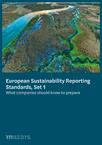What is the general approach followed by this first set of ESRS?
Sustainability reporting standards designed to meet the needs of all stakeholders, under the double materiality principle
Required by the Corporate Sustainability Reporting Directive (CSRD), the ESRS prescribe both the content and format of the sustainability statement intended to meet users’ needs for high-quality, comparable and relevant information.
The ESRS require a company to disclose information on sustainability matters under the double materiality principle, whereby companies will have to report both on the material impacts of their activities on people or the environment connected with their own operations and their upstream and downstream value chain, and on how various sustainability matters have material financial effects due to risks or opportunities generated by these matters.
12 sector-agnostic standards under four headings, covering the full spectrum of ESG topics
While Set 1 of the ESRS covers all ESG information that is likely to be material regardless of the sector(s) companies operate in, sector-specific standards will subsequently complement these sector-agnostic standards.
This represents another major step as most sustainability-related topics are relevant only when taking a sectoral approach. In addition, entity-specific information will also have to be provided, where necessary (i.e. in order to cover all the material impacts, risks and opportunities identified).
The structure of the disclosure requirements (or DRs) listed in the ESRS is aligned with the Recommendations of the Task Force on Climate-related Financial Disclosures (TCFD) and therefore covers governance, strategy, management of impacts, risks and opportunities, as well as metrics and targets.
In practice, Set 1 includes 12 general sector-agnostic standards, two cross-cutting standards and ten topical standards, including five on environmental matters, four covering social matters and one on governance.
Sustainability information fitting within corporate reporting, in consistency with other EU legislations and global initiatives
The sustainability information under the ESRS will have to be presented in a clearly identifiable dedicated section of the management report. As per the CSRD, the management report will have to be both human and machine-readable, using the European Single Electronic Format (ESEF) to tag the sustainability information.
Besides, the content of these 12 sector-agnostic standards is fully consistent with the various European policies and regulations, as incorporating in particular the information stemming from the Sustainable Finance Disclosure Regulation (SFDR), the EBA Pillar 3, the requirements of the European Benchmark Regulation, and the European Climate Law.
Beyond the European framework, a very high level of alignment between the ESRS and the Global Reporting Initiative (GRI) standards on one side, and between the ESRS and the International Sustainability Standards Board (ISSB) standards on the other side has also been achieved.
What are the main challenges for companies?
The ESRS represent a major shift, creating new demanding transparency obligations on companies as regards their commitment to sustainability, especially as the sustainability information will have to be audited (with limited assurance over compliance with the ESRS required at inception, and a possible move to reasonable assurance).
As a first step, companies should first assess whether they are within the scope of the CSRD and when they will have to publish sustainability information under the ESRS for the first time.
Challenges in implementing ESRS will depend on whether the company was already subject to the Non-Financial Reporting Directive (NFRD) requirements and in which Member State it is established, as the NFRD left significant flexibility to Member States to transpose into national law.
In all cases, first-time application of Set 1 will necessitate revisiting the materiality assessment and considering the entire value chain. Then a thorough analysis of the DRs listed in the ESRS will have to be performed in order to identify which material information has to be disclosed to cover material impacts, risks and opportunities identified by the company in relation to its sustainability matters.
What are the next developments that companies need to follow?
Adopted by the European Commission on 31 July 2023, the final text of Set 1 will be published in the OJEU by the end of 2023 (as no objection was raised by the European Parliament and the Council during their scrutiny period), for entry into force from 1 January 2024 for the first companies within the CSRD scope i.e. for large companies that are public interest entities with more than 500 employees (currently in the scope of the NFRD).
As we look ahead to the future, the ESRS are set to provide a robust basis for reporting sustainability information. In the meantime, companies should act now in order to comply with these new requirements and think about how to make this additional insight a strategic driver for their sustainability and business performance.
Download our guide on Set 1 of the ESRS below for more in-depth information on this new sustainability reporting framework and its impacts for companies, namely how to identify and present the sustainability information on which they shall report on.










